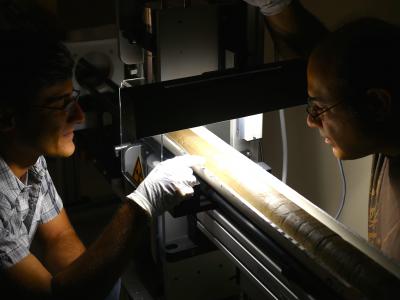Study finds abrupt climate change may have rocked the cradle of civilization

Setting up the core in multi sensor core logger (MSCL) at the paleoceanography lab at the Rosenstiel School, to make a high-resolution image and measure the physical properties such as density and magnetic susceptibility. Credit: Diana Udel, UM Rosenstiel School Communications Office
New research reveals that some of the earliest civilizations in the Middle East and the Fertile Crescent may have been affected by abrupt climate change.
These findings show that while socio-economic factors were traditionally considered to shape ancient human societies in this region, the influence of abrupt climate change should not be underestimated.
A team of international scientists led by researchers from the University of Miami (UM) Rosenstiel School of Marine and Atmospheric Science found that during the first half of the last interglacial period known as the Holocene epoch, which began about 12,000 years ago and continues today, the Middle East most likely experienced wetter conditions in comparison with the last 6,000 years, when the conditions were drier and dustier.
“Evidence for wet early Holocene was previously found in the Eastern Mediterranean Sea region, North and East African lakes and cave deposits from Southwest Asia, and attributed to higher solar insolation during this period,” said Ali Pourmand, assistant professor of marine geosciences at the UM Rosenstiel School, who supervised the project.
“Our study, however, is the first of its kind from the interior of West Asia and unique in its resolution and multi-proxy approach.”
The Fertile Crescent, a region in west Asia that extends from Iran and the Arabian Peninsula to the eastern Mediterranean Sea and northern Egypt is one of the most climatically dynamic regions in the world and is widely considered the birthplace of early human civilizations.
“The high-resolution nature of this record afforded us the rare opportunity to examine the influence of abrupt climate change on early human societies. We see that transitions in several major civilizations across this region, as evidenced by the available historical and archeological records, coincided with episodes of high atmospheric dust; higher fluxes of dust are attributed to drier conditions across the region over the last 5,000 years,” said Arash Sharifi, Ph.D. candidate at the department of marine geosciences and the lead author of the study.
The researchers investigated climate variability and changes in paleoenvironmental conditions during the last 13,000 years based on a high-resolution (sub-decadal to centennial) peat record from Neor Lake in Northwest Iran. Abrupt climate changes occur in the span of years to decades.
###
This study, which was funded by the National Science Foundation to A. Pourmand (EAR-1003639) and L. Canuel (EAR-1003529), is titled “Abrupt climate variability since the last deglaciation based on a high-resolution, multi-proxy peat record from NW Iran: The hand that rocked the Cradle of Civilization?” The paper, which will be published in the September 1 issue of the journal of Quaternary Science Reviews, is currently available online.
The study's authors include: Arash Sharifi, Ali Pourmand, Larry C. Peterson, Peter K. Swart of the UM-RSMAS; Elizabeth A. Canuel, Erin Ferer-Tyler of the Virginia Institute of Marine Science, College of William and Mary; Bernhard Aichner, Sarah J. Feakins of the University of Southern California; Touraj Daryaee of the University of California, Irvine; Morteza Djamali of the institut méditerranéen de biodiversité et d'ecologie, France; Abdolmajid Naderi Beni, and Hamid A.K. Lahijani of the Iranian National Institute of Oceanography and Atmospheric Science, Iran.
Media Contact
All latest news from the category: Earth Sciences
Earth Sciences (also referred to as Geosciences), which deals with basic issues surrounding our planet, plays a vital role in the area of energy and raw materials supply.
Earth Sciences comprises subjects such as geology, geography, geological informatics, paleontology, mineralogy, petrography, crystallography, geophysics, geodesy, glaciology, cartography, photogrammetry, meteorology and seismology, early-warning systems, earthquake research and polar research.
Newest articles

NASA: Mystery of life’s handedness deepens
The mystery of why life uses molecules with specific orientations has deepened with a NASA-funded discovery that RNA — a key molecule thought to have potentially held the instructions for…

What are the effects of historic lithium mining on water quality?
Study reveals low levels of common contaminants but high levels of other elements in waters associated with an abandoned lithium mine. Lithium ore and mining waste from a historic lithium…

Quantum-inspired design boosts efficiency of heat-to-electricity conversion
Rice engineers take unconventional route to improving thermophotovoltaic systems. Researchers at Rice University have found a new way to improve a key element of thermophotovoltaic (TPV) systems, which convert heat…



